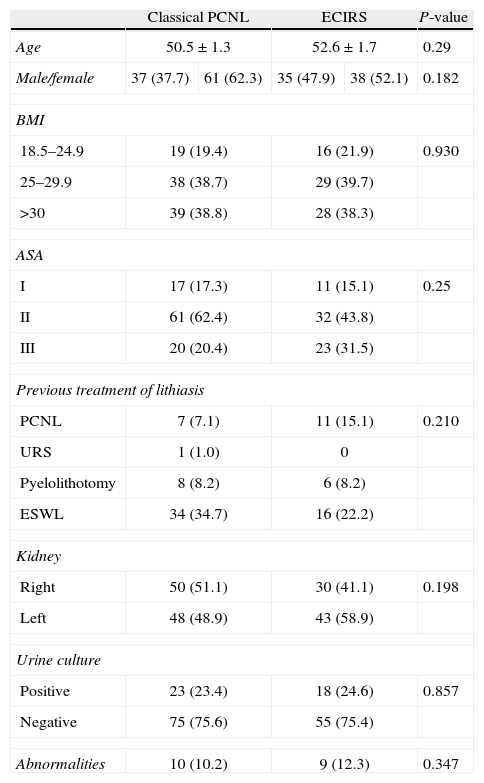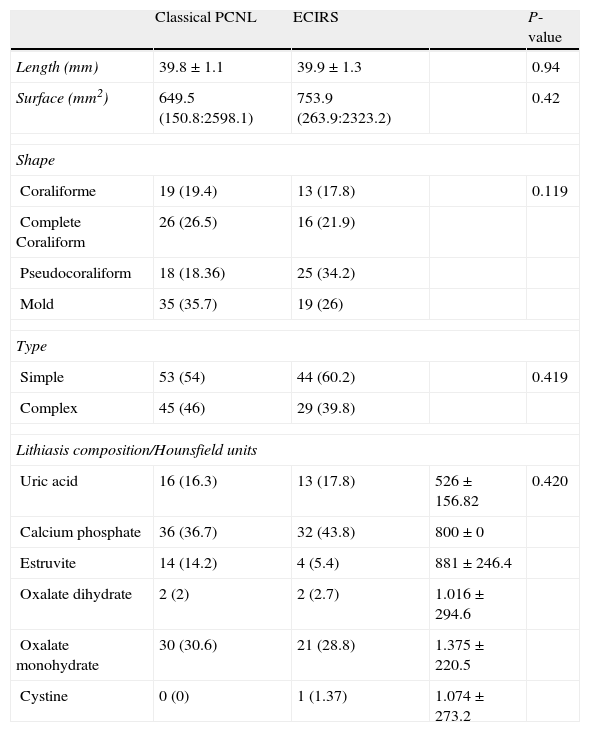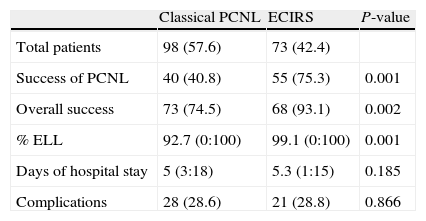To compare the results obtained in percutaneous nephrolithotomy after introduction of flexible ureteroscopy/nephroscopy (endoscopic combined intrarenal surgery – ECIRS) with nephrolitomies with only rigid nephroscopy (standard percutaneous nephrolithotomy; sPCNL).
Materials and methodsA retrospective study of 171 sPCNL in Galdakao position performed between January 2005 and December 2011 was conducted. We compared the results obtained in those procedures in which endoscopic combined intrarenal surgery (ECIRS) was performed with those in which only the rigid nephroscopy (sPCNL) was used. Specific and global success, percentage of lithiasic load eliminated, days of hospital stay and complications derived were calculated. We defined success by complete absence of lithiasis or residual presence of <5mm. We differentiated specific success, that only achieved with percutaneous surgery, from global success, or that achieved after a second line of treatment.
ResultsIn 73 procedures (42.4%) ECIRS was performed with flexible endoscopy while in 98 (57.6%) it was done with sPCNL. Both groups were comparable in regards to demographic parameters and characteristics of the lithiasis. The success rates in the first procedure and global success were superior for the ECIRS group (75.3% vs. 40.8% and 93.1% vs. 74.5%), the differences being statistically significant (P<.05). No statistically significant differences were found in regards to the complications (28.8% vs. 28.3%; P=.86) or days of hospital stay (4.5 vs. 5.0; P=.18).
ConclusionsUse of the flexible ureteroscopy/nephroscopy in sPCNL (ECIRS) improves the success rates and elimination of lithiasic load, making it possible to perform the surgery with a single access in most of the cases.
Comparar los resultados obtenidos en la nefrolitotomía percutánea tras la introducción del ureteroscopio/nefroscopio flexible (cirugía endoscópica intrarrenal combinada [CEIRC]) con nefrolitomías con solo nefroscopio rígido (nefrolitotomía percutánea estándar [NLPC]).
Material y métodoEstudio retrospectivo de 171 NLPC en posición de Galdakao realizadas entre enero de 2005 y diciembre de 2011. Comparamos los resultados obtenidos en aquellos procedimientos en los que se realizó CEIRC con aquellos en los solo se utilizó nefroscopio rígido (NLPC). Se estimó el éxito específico y el global, el porcentaje de carga litiásica eliminada, los días de estancia hospitalaria y las complicaciones derivadas. Definimos el éxito por la ausencia completa de litiasis o la presencia de residual <5mm. Diferenciamos el éxito específico, el conseguido solo con la cirugía percutánea, y el éxito global, el alcanzado tras una segunda línea de tratamiento.
ResultadosEn 73 procedimientos (42.4%) se realizó CEIRC con endoscopios flexibles, mientras que 98 (57.6%) fueron NLPC. Ambos grupos fueron comparables en cuanto a parámetros demográficos y características de las litiasis. Las tasas de éxito en el primer procedimiento y de éxito global fueron superiores para el grupo de CEIRC (75.3 vs 40.8% y 93.1 vs 74.5%), siendo las diferencias estadísticamente significativas (p<0.05). No se encontraron diferencias estadísticamente significativas en cuanto a las complicaciones (28.8 vs 28.3%; p=0.86) o los días de estancia hospitalaria (4.5 vs 5.0; p=0.18).
ConclusionesEl uso de ureteroscopio/nefroscopio flexible en la NLPC (CEIRC) mejora las tasas de éxito y de eliminación de carga litiásica, permitiendo en la mayoría de casos realizar la cirugía con un acceso único.









